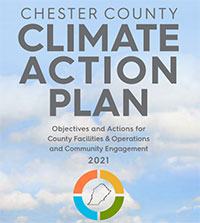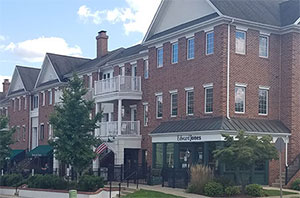Getting Started
Planning for the future of housing will require balancing a variety of often conflicting needs within communities. Addressing the trends and data in this report will take a multitude of strategies, many more than can be presented in this report. The Chester County Planning Commission has resources available to municipalities at their website, chescoplanning.org. This report section presents some starting points for municipalities to consider based on the trends and data presented in this guide.

With new challenges brought on by climate change, municipalities should promote better stormwater management, renewable energy, and land conservation practices. The recommendations below are meant only as a starting point for municipalities, the Chester County Planning commission has more extensive resources available through the Sustainability Division.
Mitigate impacts of climate change through sustainable planning and zoning policies.
- Prohibit development in floodplains.
- Regularly review ordinance requirements for stormwater management to ensure they do not prevent or limit implementation of new technologies and best practices.
- Allow additional density for infill development on parcels with access to public utilities.
- Allow renewable energy infrastructure such as wind turbines, geothermal fields, and solar farms in appropriate locations through zoning.
- Require new development to be oriented to take advantage of solar gain, wind breaks, and other natural elements that impact energy conservation.
- Incentivize above-code energy efficiency, building electrification, and renewable energy systems in new construction through density and use bonuses.
- Participate in Vision Partnership Program (VPP) grants to plan for development and implementation of local community resource protection and renewable energy planning and ordinances to ensure development does not occur in floodplain or other hazardous areas.
- Focus new development in Landscapes3 growth areas.
Support multi-modal transportation options to reduce emissions.
- Participate in multi-municipal traffic control plans and congestion management programs.
- Coordinate and maintain signal timing to reduce idling time at intersections and to install closed-loop signal systems where feasible.
- Complete pedestrian networks, inclusive of sidewalks, paths, and trails, in designated growth areas to provide an alternative to the automobile.
- Establish bicycle accommodations and share the road infrastructure and policies.
- Install public electric vehicle charging stations at public parking and municipal facilities.
- Reduce parking requirements where uses are near alternative modes of transportation.
- Support transit-oriented development along transit routes and in the vicinity of train stations by establishing higher density zoning overlays near transit facilities.
Create and participate in programs that promote sustainable practices.
- Develop free or discounted rain barrel programs.
- Participate in DVRPC's regional streetlight procurement program that converts streetlights to LED.
- Explore the use of alternatives to asphalt for use in some low traffic back roads, bike trails, and walking paths to reduce heat absorption and lower surface temperatures.
Provide information to residents and businesses
- Develop information on sustainable practices such as weatherization, LEDs, timed lighting, electric heating systems/heat pumps, and solar.
- Promote use of wood in construction as a sustainable material.
- Educate and promote reduction in food waste and composting.
Set an example by implementing sustainable practices at municipally-owned facilities.
- Convert municipal building utilities to renewable energy sources.
- Convert municipal vehicles to hybrid or fully electric vehicles.
- Implement building efficiency retrofits such as LEDs, timed lighting, electric heating systems/heat pumps, green roofs, and solar panels.
- Consider suppliers' commitment to sustainability as part of procurement process.
- Promote teleconferencing for meetings where appropriate to reduce travel emissions.
- Establish policies to reduce greenhouse gas emissions created by employee commuting through flex-time work schedules during peak commuting hours and allowing employees to work remotely when feasible and appropriate.
- Locate future municipal facilities and services in walkable areas where feasible.
- Consider lawn to meadow conversion and/or convert lawn maintenance equipment to electric vehicles and equipment where practical.
Resources

Create opportunities for diverse housing building types. Below are initial considerations for municipalities to consider; a fuller set of information can be found on the Chester County Planning Commission's website under housing.
Promote Missing Middle Housing, apartments, and mobile housing in zoning.
- Mix-in higher density Missing Middle housing forms (apartments, quadplexes, triplexes, and live-work) into commercial and light industrial districts.
- Consider lower density Missing Middle housing forms (Accessory Dwelling Units or ADUs, Single-Family conversions, twins, duplexes, and townhomes) in existing neighborhoods.
- Allow Missing Middle housing types by-right in all zoning districts at appropriate densities.
- Differentiate triplex and quadplex definitions and uses from multifamily and consider permitting them in lower density, residential districts.
- Calculate building fees based on building size and not unit count.
- Ensure lot dimensions are per square foot and not per dwelling unit.
- Provide bonuses (density, height, or use) or utilize inclusionary zoning overlays for affordably-priced housing.
- Apply short-term rental restrictions uniformly across all housing types, not just Missing Middle types.
- Exempt ADUs from maximum dwelling unit per acre counts.
- Apply parking minimums appropriate to development type and context.
- Review and update subdivision and land development ordinances to be consistent with contemporary planning best practices.
- Right-size street width requirements to accommodate traffic and emergency services needs without creating excessive cost burdens for residential development.
- Minimize cul-de-sac development.
- Consider form or performance based zoning codes.
- Implement cluster development standards and/or allow for smaller-scale cluster developments.
- Base parking requirements on number of bedrooms instead of unit count or building size.
- Apply for Vision Partnership Program funding to advance zoning for Missing Middle housing.
Encourage conversions of obsolete office and commercial buildings into residential units.
- Permit mixed-use and/or residential development by-right or with minimal requirements in areas with high vacancies.
- Consider alternative funding methods such as Low-Income Tax Credits, tax abatements, or Tax Increment Finance districts to lower the costs of conversions.
- Develop streamlined processes to address previous code violations on vacant and abandoned buildings to lower conversion costs.
- Tailor ground floor commercial requirements to specific areas, such as main streets, and not full districts to ensure they are not adding costs that create barriers to conversions.
- Adjust lot size and dimensional standards in areas where building conversions are desired to minimize needed lot changes and therefore conversion costs.
- Consider minimizing parking requirements for sites near transit.
- Update nonconformity regulations to allow for flexibility for building conversions.
- Allow for mixed-use districts and secondary uses to promote infill development on parcels with existing buildings and excess land.
Simplify the review process to decrease costs of development reviews.
- Create clear and easy approval processes.
- Develop form guides or "pattern books" that allow for faster approval processes.
- Ensure definitions are clear, unambiguous, and consistent between all ordinance chapters.
- Provide options for digital plan submissions until final reviews.
Promote public/private housing partnerships, especially employer supported housing.
- Conduct outreach to major employers to create employer supported housing programs.
- Ensure zoning is in place to allow for employer supported housing as part of their existing properties.
Encourage affordable housing development.
- Educate the public about housing needs in the county.
- Educate landlords about Housing Choice Vouchers.
- Provide information to residents and developers on Chester County Department of Community Development programs.
Resources

Allow for smaller units for decreasing household size.
- Permit greater Missing Middle Housing options throughout the community.
- Consider reduction in minimum lot sizes relative to access to public utilities.
- Permit ADUs by-right.
Create opportunities for first-time homebuyers.
- Provide information on first time homebuyer programs such as those available through the Pennsylvania Housing Finance Agency.
- Permit Missing Middle Housing options to provide greater options of housing at all income levels.
- Utilize data driven approaches when creating policy changes to ensure they are equitable.
Ensure housing policies are equitable and meet fair housing standards.
- Allow diverse housing types in multiple residential districts throughout the county.
- Connect municipal officials and staff as well as landlords and developers to Fair Housing resources provided by the Housing Equality Center of PA.
- Allow multigenerational households to reside in units.
Resources

